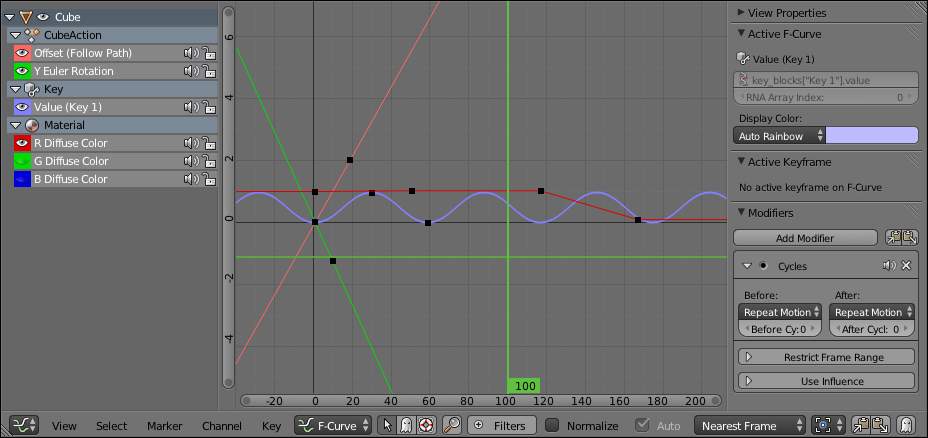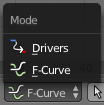Introduction¶
The Graph editor is the main animation editor. It allows you to modify the animation for any properties using F-Curves.
The graph editor has two modes, F-Curve for Actions, and Drivers for Drivers. Both are very similar in function.
Curve View¶
Here you can see and edit the curves and keyframes.
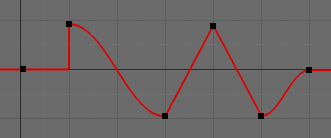
A curve with different types of interpolation.
See F-Curves for more info.
2D Cursor¶
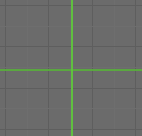
Graph Editor 2D Cursor.
The current frame is represented by a green vertical line called the Time Cursor.
As in the Timeline,
you can change the current frame by pressing or holding LMB.
The green horizontal line is called the Cursor. This can be disabled via the View Menu or the View Properties panel.
The Time Cursor and the Cursor make the 2D Cursor. The 2D Cursor is mostly used for editing tools.
View Axes¶
For Actions the X-axis represents time, the Y-axis represents the value to set the property.
For Drivers the X-axis represents the Driver Value, the Y-axis represents the value to set the property.
Depending on the selected curves, the values have different meaning: For example rotation properties are shown in degrees, location properties are shown in Blender Units. Note that Drivers use radians for rotation properties.
Header¶
View Controls¶

View Controls.
- Show Only Selected (mouse cursor icon)
- Only include curves related to the selected objects and data.
- Show Hidden (ghost icon)
- Include curves from objects/bones that are not visible.
- Show Only Errors (livesaver icon)
- Only include curves and drivers that are disabled or have errors. Useful for debugging.
- Search Filter (magnifying glass icon)
F Only include curves with keywords contained in the search field.
- Multi-Word (az icon)
- Fuzzy/Multi-Word name filtering matches word snippets/partial words, instead of having to match everything. It breaks down the search string based on whitespace placement. e.g. “lo ro” will filter all location and rotation, while “lc rt” will not work.
- Type Filter
Filter curves by property type.
- Data-block Sort (az icon)
Objects data-blocks appear in alphabetical order, so that it is easier to find where they occur (as well as helping to keep the animation of related objects together in the NLA for instance).
If you find that your playback speed suffers from this being enabled (it should only really be an issue when working with lots of objects in the scene), you can turn this off.
- Normalize
Normalize curves so the maximum or minimum point equals 1.0 or -1.0.
- Auto
- Automatically recalculate curve normalization on every curve edit. This is useful to prevent curves from jumping after tweaking it.
Curve Controls¶

Curve Controls.
- Proportional Editing
O - See Proportional editing.
- Auto Snap
Auto snap the keyframes for transformations.
- No Auto-Snap
- Frame Step
- Second Step
- Nearest Frame
- Nearest Second
- Nearest Marker
- Pivot Point
Pivot point for rotation.
- Bounding Box Center
- Center of the selected keyframes.
- 2D Cursor
- Center of the 2D Cursor. Time Cursor + Cursor.
- Individual Centers
- Rotate the selected keyframe Bézier handles.
- Copy Keyframes
Ctrl-C - Copy the selected keyframes to memory.
- Paste Keyframes
Ctrl-V - Paste keyframes from memory to the current frame for selected curves.
- Create Snapshot (ghost icon)
- Creates a picture with the current shape of the curves.
Properties Region¶
The panels in the Properties Region.
View Tab¶
View Properties Panel¶
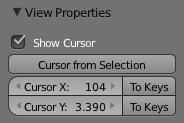
View Properties Panel.
- Show Cursor
- Show the vertical Cursor.
- Cursor from Selection
- Set the 2D cursor to the center of the selected keyframes.
- Cursor X
Time Cursor X position.
- To Keys
- Snap selected keyframes to the Time Cursor.
- Cursor Y
Vertical Cursor Y position.
- To Keys
- Snap selected keyframes to the Cursor.
Further Tabs¶
- F-Curve Tab
- See F-Curve.
- Drivers Tab
- See Drivers Panel.
- Modifiers Tab
- See F-Modifiers.
